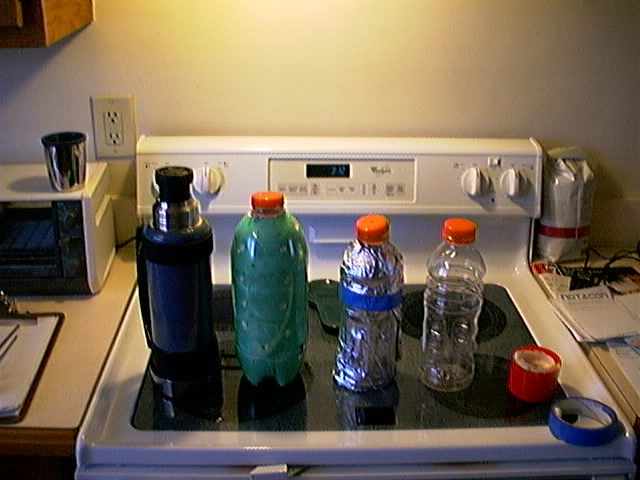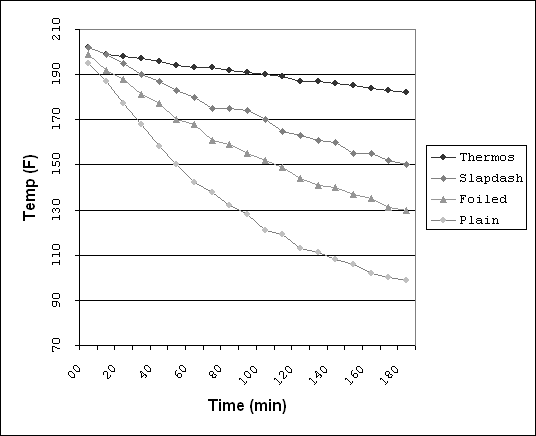Test Results
Make a thermal carafe out of leftover parts and trash!
Of course the point of a thermal carafe is to keep the contents of it from assuming room temperature. In my case, I want to keep hot liquids hot. To demonstrate whether or not I accomplished this goal, I conducted a not-very-rigorous experiment. Basically, I compared the heat-retention abilities of four vessels.
- A Thermos brand thermos
- The slapdash thermal carafe
- A 34-oz. plastic bottle, wrapped in foil, identical to the one at the core of the slapdash thermal carafe
- Another 34-oz. plastic bottle with no foil wrapper

Click to embiggen
I filled each vessel with about 30 oz. of hot water (about 200°F) and measured their temperatures every 10 minutes for three hours.
Now, there were four test vessels, and I only had three kitchen thermometers available. That already implies two sources of experimental error: first, I was measuring temperatures with different instruments, and second, at any given time I had to juggle thermometers between vessels. At the start of the test, I calibrated all three thermometers to the same temperature.
Another source of experimental error was that I couldn't seal any of the vessels properly, because I needed to put the thermometer into it. For the three bottle-based samples, I drilled a hole in the plastic lids and put the thermometer through. For the Thermos, I left the top slightly askew. Whichever plastic bottle didn't have a thermometer in it at the time got covered with the foam-filled spray paint cap at the right of the photo above.
I guess I should also mention that I pre-heated all four vessels, and all of the test equipment with hot tap water (about 119°F), and the ambient temperature was 71°F. I realize that Farenheit is old and busted, and that Celsius is the new hawtness, but since all of my instruments measure in Farenheit, that's what I am reporting.

Click to embiggen
The results were mostly as expected. The Thermos-brand thermos lost the least heat (20°F); the slapdash thermal carafe lost the second-least (52°F); next was the foil-wrapped bottle (69°F); the worst performer was the plain plastic bottle (96°F). It is worth mentioning that probably all of these vessels would have lost less heat if they had been properly sealed.
It is also important to note that, as it states in the build log for this project, the test was conducted before construction of the slapdash thermal carafe was completed. Specifically, additional insulation was added to the top of the carafe, the cap was insulated, and an external skin of duct tape was added. These should improve its performance, but the new configuration has not been tested.
While the homemade thermal carafe does not perform nearly as well as the brand-name Thermos, it is good enough to keep a pot of coffee drinkably hot for an hour or so -- more than enough time to commute to work.

